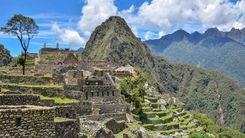The pretty village of Chavín de Huantar, with its whitewashed walls and traditional tiled roofs, is just a couple of hundred metres from the ruins and has a reasonable supply of basic amenities.
Brief history
The original temple was built here around 900 BC, though it was not until around 400 BC that the complex was substantially enlarged and its cultural style fixed. Some archeologists claim that the specific layout of the temple, a U-shaped ceremonial courtyard facing east and based around a raised stone platform, was directly influenced by what was, in 1200 BC, the largest architectural monument in the New World, at Sechin Alto. By 300 BC, Sechin Alto had been abandoned and Chavín was at the height of its power and one of the world’s largest religious centres, with about three thousand resident priests and temple attendants. The U-shaped temples were probably dedicated to powerful mountain spirits or deities, who controlled meteorological phenomena, in particular rainfall, vital to the survival and wealth of the people.
The temple area
The complex’s main temple building consists of a central rectangular block with two wings projecting out to the east. The large, southern wing, known as the Castillo, is the most conspicuous feature of the site: massive, almost pyramid shaped, the platform was built of dressed stone with gargoyles attached, though few remain now.
Some way in front of the Castillo, down three main flights of steps, the Plaza Hundida, or “sunken plaza”, covers about 250 square metres with a rectangular, stepped platform to either side. Here, the thousands of pilgrims thought to have worshipped at Chavín would gather during the appropriate fiestas. And it was here that the famous Tello Obelisk, now in the Museo de Arqueología, Antropología e Historia in Lima, was found, next to an altar in the shape of a jaguar and bedecked with seven cavities forming a pattern similar to that of the Orion constellation.
Standing in the Plaza Hundida, facing towards the Castillo, you’ll see on your right the original temple, now just a palatial ruin dwarfed by the neighbouring Castillo. It was first examined by Julio Tello in 1919 when it was still buried under cultivated fields; during 1945 a vast flood reburied most of it and the place was damaged again by the 1970 earthquake and the rains of 1983. Among the fascinating recent finds from the area are bone snuff tubes, beads, pendants, needles, ceremonial shells (imported from Ecuador) and some quartz crystals associated with ritual sites. One quartz crystal covered in red pigment was found in a grave, placed after death in the mouth of the deceased.
The subterranean chambers
Behind the original temple, two entrances lead to a series of underground passages and subterranean chambers. The passage on the right leads down to an underground chamber, containing the awe-inspiring Lanzon, a prism-shaped 4.5m block of carved white granite that tapers down from a broad feline head to a point stuck in the ground. The entrance on the left takes you into the labyrinthine inner chambers, which run underneath the Castillo on several levels connected by ramps and steps. In the seven major subterranean rooms, you’ll need a torch to get a decent look at the carvings and the granite sculptures (even when the electric lighting is switched on), while all around you can hear the sound of water dripping.
Another large stone slab that was originally discovered at Chavín in 1873 – the Estela Raymondi – is now in the Museo Nacional de Arqueología, Antropología e Historia in Lima; this was the first and most spectacular of all the impressive carved stones to be found. The most vivid of the carvings remaining at the site are the gargoyles (known as Cabeza Clavos) along the outer stone walls of the Castillo sector, guardians of the temple, which again display feline and bird-like characteristics.



